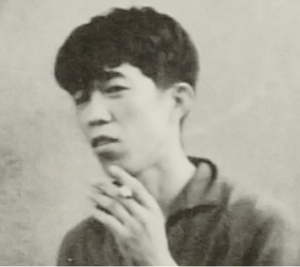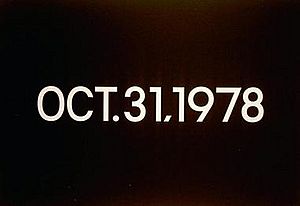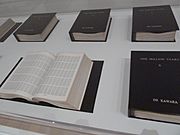On Kawara facts for kids
Quick facts for kids
On Kawara
|
|
|---|---|
 |
|
| Born | December 24, 1932 |
| Died | July 10, 2014 (aged 81) New York City, New York, United States
|
| Nationality | Japanese |
| Known for | Visual art, conceptual art |
On Kawara (河原温 (Kawara On, December 24, 1932 – July 10, 2014)) was a Japanese conceptual artist. He lived in New York City from 1965. Conceptual art is a type of art where the idea behind the artwork is more important than the finished art object itself. Kawara took part in many art shows around the world.
Contents
Early Life and Travels
On Kawara was born in Kariya, Japan, on December 24, 1932. After finishing high school in 1951, he moved to Tokyo. In 1959, Kawara went to Mexico for three years. He painted, studied art, and explored the country.
From 1962 to 1964, he traveled between New York and Paris. He also explored other parts of Europe. In 1965, he settled in New York City. He lived there off and on until he passed away.
What Kind of Art Did On Kawara Make?
On Kawara was part of a group of international artists in the mid-1960s. These artists focused on ideas and information in their art. They made art less about personal feelings or fancy objects. Instead, they used simple ideas and language.
Paris-New York Drawings
Between 1962 and 1964, Kawara created about 200 drawings. These were called Paris-New York Drawings. Some of them had simple patterns like stripes and grids. Others showed art installations, which are artworks that fill a room.
The Today Series: Date Paintings

Starting on January 4, 1966, Kawara began a long series of "Date Paintings." This series is also known as the Today series. Each painting shows only the date it was made. The date is written in simple white letters on a solid background.
The date is always written in the language of the country where Kawara made the painting. For example, if he was in Iceland, it would be in Icelandic. If the country didn't use the Roman alphabet, he used Esperanto. These paintings are a type of word art.
The paintings are made with Liquitex paint on canvas. They come in eight standard sizes. Most are horizontal. However, three special paintings made in July 1969 were larger. These were made when the world was watching the moon landing.
Kawara painted the dates very carefully by hand. The dates are always in the center and white. The background colors change. Early paintings often had bright colors. Later ones used darker shades. If Kawara could not finish a painting on the day he started it, he destroyed it.
When a Date Painting is not on display, it is stored in a special cardboard box. Inside the box is a newspaper clipping from the city where the painting was made. Most clippings are from The New York Times. These boxes are part of the artwork, but they are rarely shown. Kawara made between 63 and 241 paintings each year.
Each Date Painting is recorded in a special journal. It is also marked on a One Hundred Years Calendar. In the journal, Kawara glued a small piece of the paint he used. He also noted the painting's order for that year and its size. The journals show details like the painting's size, color, and newspaper headline. The calendar uses colored dots to show when a painting was made. It also tracks how many days had passed since Kawara's birth. He made almost 3,000 date paintings in over 112 cities. He planned to continue this project until he died.
Title and Postcards
Similar to the Today series, Kawara sometimes used the number of days he had been alive as a title. For example, a piece called Title at the National Gallery of Art has the number 26,697. This number represents the days Kawara had lived until January 27, 2006. If you count back, it shows his birthdate was December 24, 1932.
Other works include the I Went and I Met series. For these, Kawara sent postcards to his friends. The postcards shared details about his life. He also sent telegrams to people with the simple message "I AM STILL ALIVE."
From 1968 to 1979, Kawara created the I Got Up series. He sent two picture postcards each morning from wherever he was. These 1,500 cards listed the time he woke up, the date, his location, and the receiver's name and address. Another postcard series, I Got Up At, simply had the time he woke up stamped on it. He traveled a lot, sending postcards from many different cities.
One Million Years
One Million Years is one of Kawara's most famous works about time. It lists every year for one million years before the artwork was made. It also lists every year for one million years after. Sometimes, people perform this artwork. Pairs of performers read the dates aloud from each list. They read One Million Years [Past] and One Million Years [Future] at the same time.
This artwork was first created in 1969. The first time it was read aloud was in 1993. This happened during Kawara's year-long art show in New York. Visitors could listen to One Million Years [Future] while seeing One Million Years [Past] and some date paintings.
In 2002, a very long public reading of One Million Years took place. It was at an art show called documenta 11. People sat in a glass room and took turns reading dates for 100 days. In 2004, the project went to Trafalgar Square in London. There, it was read continuously outdoors for 7 days and 7 nights. Since then, readings have happened in many cities around the world.
One-Hundred-Year Calendars
Kawara also made one-hundred-year calendars. Starting from his birth date, he marked each day of his life with a yellow dot. If he finished a date painting on a day, he marked it with a green dot. Red dots meant he completed more than one painting that day.
Pure Consciousness
In 1998, Kawara started a traveling exhibition called Pure Consciousness. He loaned seven Date Paintings (from January 1 to January 7, 1997) to schools and kindergartens. These schools were in many different countries, like Madagascar, Australia, and Japan. The paintings hung in classrooms. Their dates fell within the lifespans of the children in those classes.
Art Shows and Exhibitions
Kawara's first art shows were in Tokyo in 1953 and 1954. His work was shown at New York's Dwan Gallery in 1967. His solo show "One Million Years" was displayed in Düsseldorf, Paris, and Milan in 1971. Kawara's art was also part of important international shows like documenta (in 1972, 1982, and 2002) and the Venice Biennale (in 1976).
His art has been included in many shows about conceptual art. These include the important "Information" show at the Museum of Modern Art in New York in 1970. Solo exhibitions of his work have been held at places like the Centre Pompidou in Paris and the Dia Center for the Arts in New York.
Kawara's first big show looking back at all his work was called “On Kawara—Silence”. It was at the Solomon R. Guggenheim Museum in 2015. Kawara himself planned how the show would be set up. It also included a live reading of his “One Million Years” artwork.
Artist Books
On Kawara created several artist's books, which are artworks in book form:
- One Million Years, 1999 (2 Volumes)
- I MET, 2004 (12 Volumes)
- I WENT, 2007 (12 Volumes)
- I GOT UP, 2008 (12 Volumes)
- Trilogy, 2008 (3x12 Volumes)
- I READ, 2017 (6 Volumes)
Art Market
On Kawara's "Date Paintings" have sold for a lot of money. In 2007, one painting sold for $1.8 million at Christie's in New York. Another painting, May 1, 1987, set a new record for his work. It sold for almost $2 million in 2014.
Death
On Kawara passed away in New York on July 10, 2014. He was 81 years old. His obituaries (announcements of his death) often stated that he had been alive for 29,771 days, instead of giving his birth and death dates. His own "100 Years Calendar" showed he was born on December 24, 1932.
How On Kawara Influenced Other Artists
On Kawara's unique way of making art has inspired many other artists.
- The art group MTAA created onKawaraUpdate (v2) (2007). This software project updates Kawara's date paintings automatically.
- American artist Eric Doeringer has remade some of Kawara's projects. He made Today paintings using his own birthday. He also recreated Kawara's daily I Got Up, I Met, I Went, and I Read projects.
- British artist David Michael Clarke reworked Kawara's Today series into Today Marriages 1969 - 1999 (2001).
- British artist Jonathan Monk used Kawara's I Got Up At series in his work Return to Sender (2004).
- I am Still Alive is an art installation by Martin John Callanan (artist) that is inspired by On Kawara.
- The Japanese artist Tatsuo Miyajima uses numbers in his art, which was influenced by On Kawara.
- Chilean artist Alfredo Jaar created the Rwanda Project (1994-2000). He sent postcards with names of people who were still alive after the Rwandan genocide. This was a way to change Kawara's "I am Still Alive" telegrams.
- Rakawa.net is a micro-blogging website. It honors On Kawara's work by letting users share what they achieved each day.
- Brazilian artist Marcelo de Melo creates QR codes every July 10th. These codes state how many years On Kawara has been dead. This is a direct reference to Kawara's "I Am Still Alive" telegrams.


